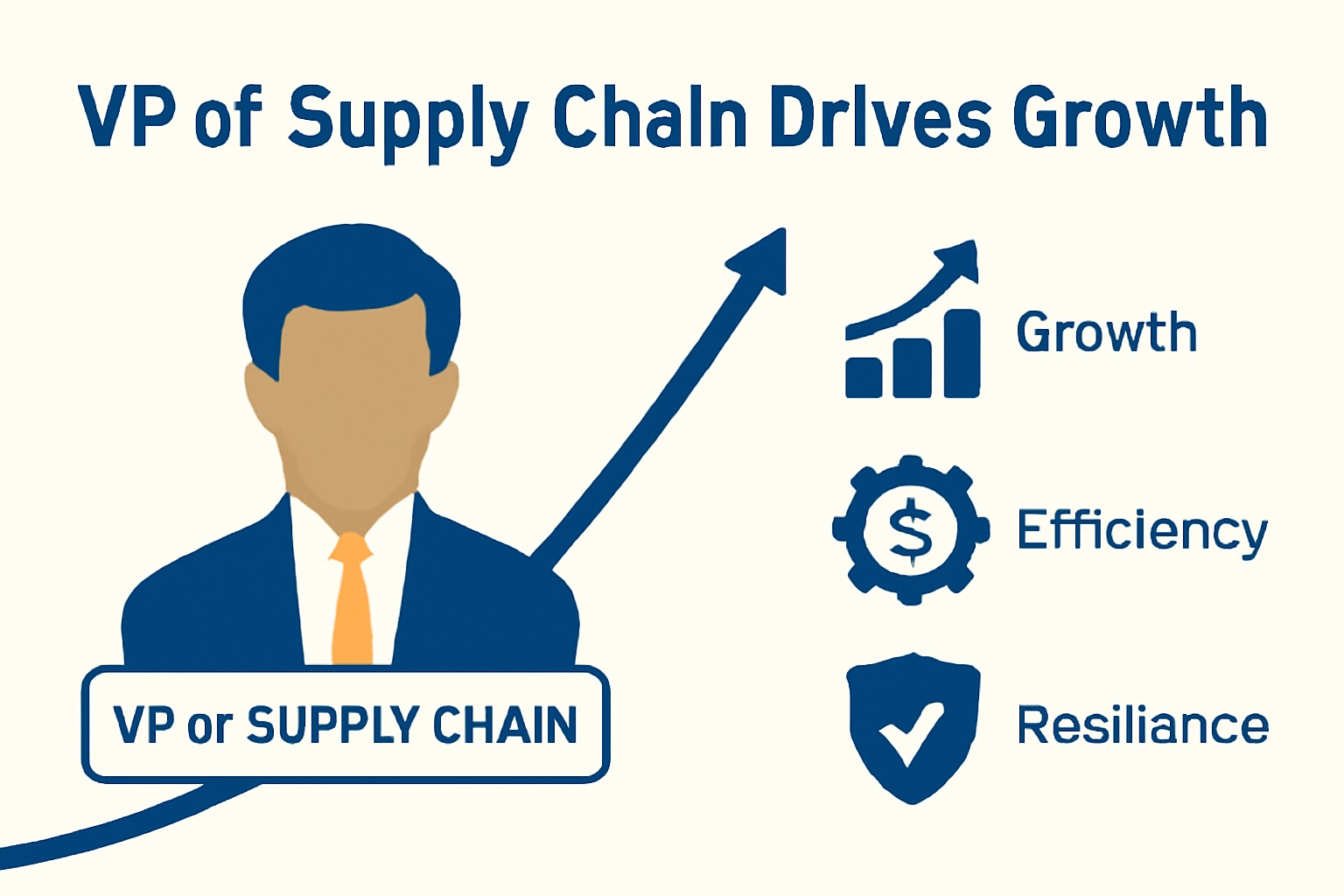Is a Vce President Of Supply Chain Vital To Growth?

According to McKinsey & Company, businesses experienced $ 1.9 trillion in losses due to global disruptions in the supply chain during 2023. The combination of logistical delays, along with deficiencies and increased transport expenses, has resulted in reduced profit margins. Companies with a robust management of the supply chain demonstrated faster recovery time and achieved superior cost management during disturbances.
This raises a key question for business owners and boards: Should a company invest in executive leadership in supply chain to improve long-term performance?
Hiring a Vice President (VP) of Supply Chain is not just about handling shipments or warehouse operations. It is about guiding the entire process from supplier management to final delivery. When companies reach a certain size or face growth challenges, this leadership role becomes important for maintaining control, reducing waste, and increasing predictability.
What does a VP with supply chain do?
The vice-president of supply chain oversees the entire logistics and information network. The role includes overseeing purchases as well as logistics alongside inventory management and storage operations, while planning production and maintaining supplier connections. The manager must minimize delays while keeping costs under control and enable quick business responses to demand changes.
The vice president works together with sales, finance, and operations departments to match inventory with demand predictions. When the marketing team designs a major campaign, the VP arranges for products to reach all necessary locations at the appropriate times. They establish systems to monitor performance measurements, which include order accuracy rates, delivery schedules, and unit costs.
Why the leadership chain is important for growth
Growth often brings complexity. Business expansion into new markets or regions requires companies to manage new supplier relationships alongside different transportation regulations and diverse customer demands. The VP role enables organizations to develop standard operating procedures while centralizing data and managing multiple dynamic components.
The absence of this leadership position forces many expanding businesses to rely on either divided teams or obsolete systems. Businesses without proper leadership may experience mistakes and financial penalties while failing to meet project timelines. Through their leadership, a VP simplifies decision-making processes while introducing advanced tools that lead to more predictable supply chain operations.
This role also reduces the risk. Whether it is a natural disaster or a supplier that goes bankrupt, VP prepares the business to respond without losing speed. This type of resilience means something when a company scales quickly.
Key qualities of an effective vice-presidential supply chain
To support growth, a vice-president of supply chain must:
- Understand demand forecast and capacity planning
- Build strong relationships with suppliers
- Negotiate better contracts and prices
- Use technology to automate processes
- Align supply chain goals with company strategy
- Lead teams and communicate clearly among departments
A successful vice-president not only reacts to problems; They build systems to avoid them. For example, if a prime story is late, it has backup suppliers or security stock on site. This keeps production in operation and satisfies customers.
The Strategic Role of a VP in Modern Business
As supply chains become more global and technology-driven, the role of a VP Supply Chain is evolving. They’re now at the core of strategic decision-making, not just operations. This includes:
1. Enabling Scalable Growth
A well-managed supply chain allows businesses to expand without chaos. VPs plan for demand fluctuations, seasonal trends, and new market entries. They prepare the infrastructure needed for growth.
2. Cost Efficiency and Margin Protection
Supply chain accounts for up to 70% of a product’s total cost. A skilled VP makes data-driven decisions to lower transportation, warehousing, and procurement costs, directly improving profit margins.
3. Risk Management and Resilience
From COVID-19 to Suez Canal blockages, disruptions are now the norm. VPs implement risk mitigation plans — dual sourcing, nearshoring, or buffer inventories — so operations can withstand the unexpected.
4. Sustainability and ESG Alignment
Today’s VPs must consider environmental goals. They introduce greener packaging, efficient routes, and ethical sourcing to align with corporate social responsibility (CSR) expectations.
Supply Chain Entities and Functions a VP Oversees
To grasp the scale of the role, here’s a breakdown of what a Vice President of Supply Chain usually supervises:
| Function | Responsibility |
| Procurement | Negotiating and sourcing materials/suppliers |
| Inventory Management | Optimizing stock levels and reducing waste |
| Logistics & Transportation | Managing shipping, warehousing, and delivery |
| Demand Planning | Forecasting customer needs and aligning resources |
| Supply Chain Analytics | Using data tools to improve decisions and KPIs |
| Vendor Management | Maintaining supplier relationships and contracts |
| Supply Chain Technology | Overseeing ERP, SCM, and automation systems |
Each of these areas, if mismanaged, can create bottlenecks or cost overruns. The VP ensures all these components move in sync.
Supply chain VPS drives profit margins
Margins are often tight in competitive industries. The VP protects company margins through efficiency improvements and waste reduction. Their savings from transportation cost management, alongside warehouse space optimization and inventory turnover improvements, directly benefit the bottom line.
The Deloitte study shows that businesses with sophisticated supply chain practices achieve 70% better performance compared to those that lack such practices. An experienced VP integrates advanced supply chain practices into the daily activities of the business. The company experiences reduced stockouts while simultaneously reducing overproduction, which leads to more predictable outcomes.
Technology and the Modern Supply Chain VP
Supply chains today are powered by software and data. Modern VPs use tools such as:
- ERP systems for planning and forecasting
- GPS tracking for shipments
- AI tools for supplier risk assessment
- Dashboards for real-time visibility
The VP must be comfortable with these tools and know how to use them to improve decisions. They turn raw data into clear actions, such as when to reorder stock or how to reroute shipments during a delay.
But technology alone is not enough. The VP knows when human judgment is needed, especially in unexpected situations. They combine tech with experience to support better business outcomes.
When Should a Company Hire a VP of Supply Chain?
A growing company should consider hiring a VP when:
- Logistics costs become a large share of expenses
- Delays start to affect customer satisfaction
- Supply chain decisions take too much executive time
- Expansion into new markets increases complexity
- Inventory control becomes harder to manage
Early hiring of a VP helps prevent chaos later. It also signals to investors and customers that the company takes operations seriously. This can improve credibility and trust.
Skills That Make a Supply Chain VP Truly Valuable
The essential skills you search for will differentiate suitable candidates for this position during selection or promotion.
- Cross-functional leadership: Coordinates with sales, finance, and marketing
- Data-driven decision making: Leverages KPIs and dashboards effectively
- Global sourcing experience: Manages suppliers across countries
- Tech literacy: The candidate shows understanding of ERP systems, together with WMS solutions and artificial intelligence forecasting tools.
- Crisis management: Has a track record of navigating disruptions
- Strategic mindset: The supply chain strategy matches the 3–5 year goals of the company
A Vice President who does not possess these competencies functions primarily as an advanced operations manager. A genuine VP Supply Chain initiates transformations within the organization instead of merely managing existing procedures.
Final Thoughts
After 2025, growth requires effective execution beyond just sales. Your business will generate more trust and recurring customers when you fulfill your commitments quickly and consistently. The Vice President of Supply Chain takes charge to ensure execution reaches its intended goals.
They don’t just move products. They move the strategy forward.
Executive-level supply chain leadership investment becomes essential when your business strives to scale up and lower costs or improve sustainability, or needs to endure future global disruptions.



